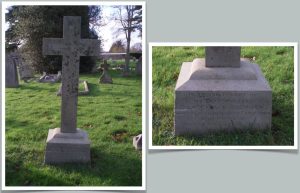Royal Army Service Corps

George Robinson (who may have been known as ‘Dick’) came from a family of agricultural workers.
He was born in either late 1893 or early 1894, at Woodmancote, near Cheltenham. His father William lived from 1839-1914 and his mother Eliza (‘Lizzie) from 1846-1921.
According to the 1911 Census the couple had five children, of whom four were living at the time of the census: sons John, Charles and George and daughter Jane.
It would appear that up until the time he married George lived with his parents at Hillside, Cleeve Hill, near Bishop’s Cleeve.
George married Rose Annie Skinner (born 1854), at St Peter’s Church, Cheltenham in April 1913. In May 1916 Rose gave birth to a daughter, Rose Mary Elizabeth.
Unusually, George’s Army Service Record survived the incendiary bombs dropped by the Luftwaffe on London in 1940, albeit in a damaged form. His record tells us that he attested for military service, for the duration of the war, on 6 June 1916 – when conscription had been operating for three months.
He stated his age to be 33 years and six months, his occupation as a farmer and that he had no previous military service. His stated address was Little Slades, Cleeve Hill.
As was the custom, following attestation he was placed into the Reserve and awaited mobilisation which came on 19 January 1917, when he joined the Army Service Corps (ASC) (the pre-fix ‘Royal’ came later).
He joined as a Driver and the letter prefix to his number, T/291142, indicates that he was posted to the ASC’s Horse Transport (HT).
Due to the damaged condition of George’s Army Service Record, it is not clear as to the exact ASC units with which he served. However, what can be ascertained is that following mobilisation he was posted to a depot at Woolwich, no doubt to undergo basic training and on 25 July 1917 he transferred to Blackheath, where the ASC had a riding training school.
On 22 August he was moved to another unit or depot: the name is indecipherable but was possibly the Remount Centre at Shirehampton, near Avonmouth. He left Shirehampton on 12 December 1917 and travelled via Le Havre, to join the Expeditionary Force sent to Italy to boost Italian resistance to the advance of the Austro-Hungarian Army after the Battle of Caporetto.
His record notes that the occurrence of a sebaceous cyst caused him to be treated at a casualty clearing station from 10 to 18 May 1918.
He remained in Italy until 15 February 1919, when he returned to the UK to be demobilised.
Evidently he was back in Gloucestershire by 21 February when he was admitted to Suffolk Hall Red Cross Hospital, Cheltenham, suffering from influenza and bronchitis. Almost certainly he had fallen victim to the ‘Spanish Flu’ pandemic and he died in hospital at 4.30am on 27 February, aged 35.
A recently released Pension Record Card states that his death was the result of ‘pneumonia contracted on active service’.
Driver George Robinson was buried in Cheltenham Cemetery on 1 March 1919 and a standard CWGC headstone now marks his grave. It is believed that he is the ‘G. Robinson’ commemorated on the Bishop’s Cleeve War Memorial.
There is another tragic twist to this story. George and Rose Robinson only had one child, Rose Mary Elizabeth. A little over a month following the death of her father, on 31 March 1919 Rose, died aged two years. A copy of her death certificate is contained in her father’s Army Service Record papers: she died from ‘influenza, bronchitis and cardiac failure’ at 85 Tewkesbury Road, Cheltenham. Another victim of ‘Spanish Flu’ it would appear.
Rose Robinson was granted a pension from 1 September 1919.
In 1925 she married Victor William Turner and went to live near Redditch in Worcestershire. Her marriage certificate shows her occupation as a teacher.
Research by Graham Adams 9 July 2020
